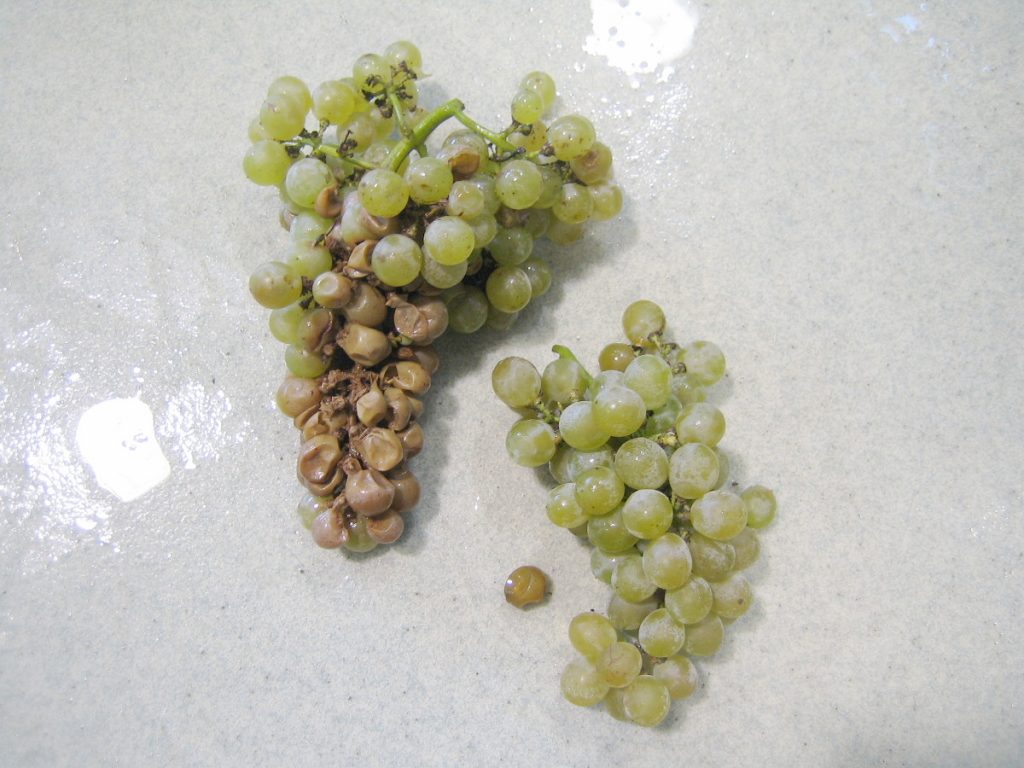
Photo by: Denise M. Gardner
Most grape diseases have an influence in wine quality in a detrimental way. Winemakers, however, can make processing decisions to help minimize that negative influence from grape disease on wine quality. For a full list of production choices when dealing with diseased fruit, please visit the webinar and downloadable notes, “Creatively Perfecting Wines from Challenging Vintages” as well as the article, “Process Decisions: Dealing with Botrytis, Gray Mold.”
This post, however, will focus on three of the most quality-driven considerations winemakers can do to make their wines cleaner and of higher quality when dealing with challenging fruit.
Get the Wine Off the Gross Lees
When grapes are prevalent with disease, some of those disease byproducts ultimately stay in the lees that immediately falls post-fermentation. This is the gross lees that settles within the first 24 hours post-fermentation.
Removing the lees from contact with the newly fermented wine can help minimize the continued extraction of those disease-driven byproducts. Why remove the byproducts? Because these components can contribute to off-flavors or soluble solids that lead to filtration problems.
Use Tank Temperature Control
Grapes that were subjected to disease prior to fermentation obviously run a risk for post-fermentation spoilage. Therefore, maintaining adequate sulfur dioxide concentrations and minimizing oxygen exposure is an essential component of post-fermentation processing. This is where having tank mixers for making additions (e.g., fining agents, additives, sulfur dioxide, sugar, etc.) can be world’s more advantageous as they incorporate less oxygen than many alternative options for mixing operations.
Another contributor to maintaining quality in these situations is the wine’s temperature. For wineries that lack tank temperature control options, spoilage is usually accelerated as the cellar is held above 60°F. This increased temperature also drives free sulfur dioxide off quicker and the wine can objectively lose more aroma and flavor aromatics that provide positive characteristics to the wine.
Bonus tip: Using the sulfur dioxide strategies described in “Demystifying Sulfur Dioxide” can minimize the potential for wine spoilage when sulfur dioxide is used strategically.
Holding wines in tank at 48 – 50°F is more preferable, as most spoilage organisms cannot grow (or cannot grow quickly) at those lower temperatures. Even red wines in barrel are usually held at 45 – 55°F in a high relative humidity environment to preserve freshness of the wine. Even if the wine did not have disease issues, holding wines at the appropriate temperature during storage can increase longevity of the wine.
Bonus tip: If the wine isn’t at the quality bar that is preferred, don’t get stuck labeling that wine as it usually is year-in and year-out. Think outside the box. Consider alternative wine styles that are either currently produced or yet to be discovered for the wine brand. I cover this more extensively in the “Creatively Perfecting Wines from Challenging Vintages” and “Creative Wine Styles for Hybrid Wines” webinar and downloadable notes.
Use of Enzymes Pre-Filtration
In years that are heavy with Botrytis, glucans can build up within the wine and cause filtration problems. Easily clogged filters are time-consuming, frustrating, and ultimately cause unnecessary wine movement. In these situations, using a glucanase enzyme can break up those glucans prior to filtration, and allow for an easier filtration process. Many enological suppliers carry glucanase enzymes or pre-filtration enzymes that help break up large soluble components associated with filtration problems.
If you add an enzyme and still have an issue filtering the wine, it may be necessary to send the wine to an enological lab to assess the filterability problem.
